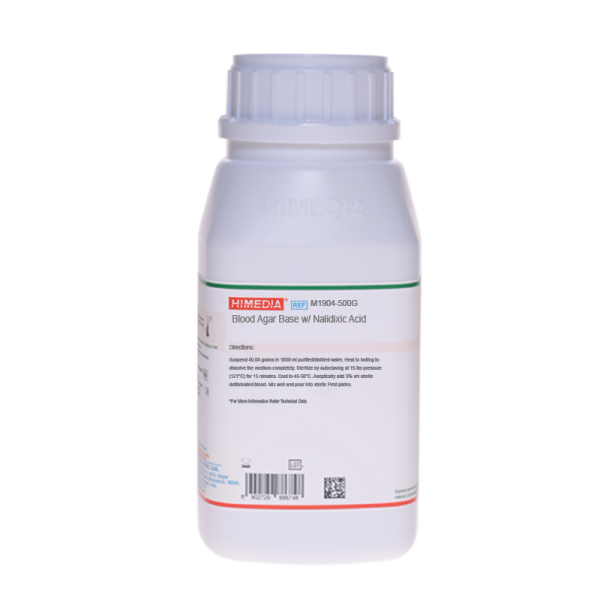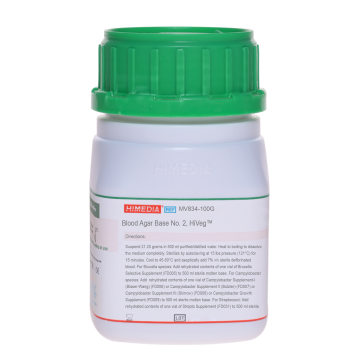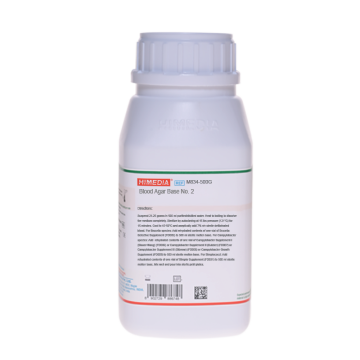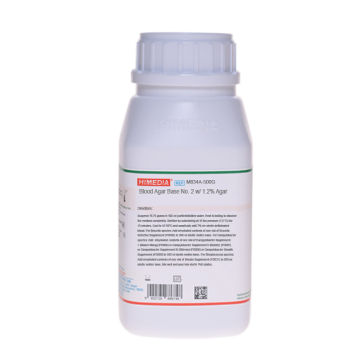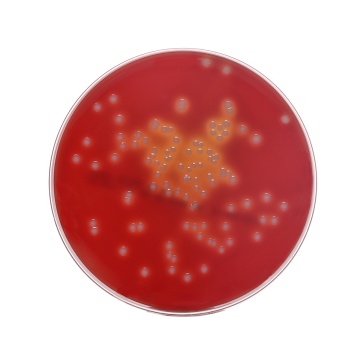 Your enquiry has been submitted
Your enquiry has been submitted
Blood Agar Base w/ Nalidixic Acid
Intended use
Recommended for the differentiation of haemolytic activity of Streptococci.
Composition
| Ingredients | g / L |
|---|---|
| HMH infusion # | 10.000 |
| HM peptone ## | 10.000 |
| Sodium chloride | 5.000 |
| Nalidixic acid | 0.040 |
| Agar | 15.000 |
Final pH ( at 25°C) 7.3±0.2
**Formula adjusted, standardized to suit performance parameters
# Equivalent to Heart infusion
## Equivalent to Meat peptone
Directions
Suspend 40.04 grams in 1000 ml purified/distilled water. Heat to boiling to dissolve the medium completely. Sterilize by autoclaving at 15 lbs pressure (121°C) for 15 minutes. Cool to 45-50°C and aseptically add 5% v/v sterile defibrinated blood. Mix well and pour into sterile Petri plates.
Principle And Interpretation
A fastidious organism is one with complete nutritional requirements, needing additional cellular building-block molecules in order to survive (1). Blood Agar Base is a highly nutritive medium. Microorganisms producing haemolysin give visible haemolytic zones on this medium. Blood Agar Base is modified with addition of Nalidixic acid which acts as an inhibitor for the accompanying flora and to support the growth of Staphylococci, haemolytic Streptococci and Enterococci when supplemented with 5% blood. Nalidixic acid blocks the DNA replication of susceptible bacteria and acts against many Gram negative bacteria(2).
HMH infusion and HM Peptone are rich source of carbon, nitrogen, amino acids, vitamins and minerals. Sodium chloride maintains the osmotic balance. Blood is an additional source that provides growth factors for the microorganisms and is the basis for determining haemolytic reactions. Haemolytic patterns may vary with the source of animal blood or type of base medium used (3).
Type of specimen
Clinical material : faeces
Specimen Collection and Handling
For clinical samples follow appropriate techniques for handling specimens as per established guidelines (4,5). After use, contaminated materials must be sterilized by autoclaving before discarding.
Warning and Precautions
In Vitro diagnostic use only. For professional use only. Read the label before opening the container. Wear protective gloves/protective clothing/eye protection/face protection. Follow good microbiological lab practices while handling specimens and culture. Standard precautions as per established guidelines should be followed while handling clinical specimens. Safety guidelines may be referred in individual safety data sheets.
Limitations
- Addition of sheep blood is recommended to detect haemolysis. This medium does not support the growth of H.haemolyticus.
- Addition of Horse blood or rabbit blood to base medium supports growth of H.haemolyticus but resemble beta haemolytic Streptococci and hence must be confirmed.
- Haemolytic pattern varies with the source of blood used.
Performance and Evaluation
Performance of the medium is expected when used as per the direction on the label within the expiry period when stored at recommended temperature.
Quality Control
Appearance Cream to yellow homogeneous free flowing powder
Gelling Firm, comparable with 1.5% Agar gel
Colour and Clarity of prepared medium Basal medium : Yellow coloured clear to slightly opalescent gel. After addition of 5-7% v/v sterile defibrinated blood: Cherry red coloured opaque gel forms in Petri plates.
Reaction Reaction of 4.25% w/v aqueous solution at 25°C. pH : 7.3±0.2
pH 7.10-7.50
Cultural Response Cultural characteristics observed with added 5-7% sterile sheep defibrinated blood, after an incubation at 35-37°C for 18-48 hours.
| Organism | Inoculum (CFU) | Growth | Recovery | Haemolysis |
|---|---|---|---|---|
| Staphylococcus epidermidis ATCC 12228 (00036*) | 50-100 | good | >=50% | |
| Staphylococcus aureus subsp. aureus ATCC 25923 (00034*) | 50-100 | none-poor | <=10% | beta |
| Streptococcus pneumoniae ATCC 6303 | 50-100 | good-luxuriant | >=50% | alpha |
| Streptococcus pyogenes ATCC 19615 | 50-100 | good-luxuriant | >=50% | beta |
| Escherichia coli ATCC 25922 (00013*) | >104 | inhibited |
Key : (*) - Corresponding WDCM numbers
Storage and Shelf Life
Store between 2-8°C in a tightly closed container and the prepared medium at 2-8°C. Use before expiry date on the label. On opening, product should be properly stored dry, after tightly capping the bottle in order to prevent lump formation due to the hygroscopic nature of the product. Improper storage of the product may lead to lump formation. Store in dry ventilated area protected from extremes of temperature and sources of ignition Seal the container tightly after use. Product performance is best if used within stated expiry period.
Disposal
User must ensure safe disposal by autoclaving and/or incineration of used or unusable preparations of this product. Follow established laboratory procedures in disposing of infectious materials and material that comes into contact with clinical sample must be decontaminated and disposed of in accordance with current laboratory techniques (4,5).
Reference
- Norton C. F., 1986, Microbiology, 2nd Edition, Addison-Wesley Publishing Company.
- Cruikshank.R(1972), Medical Microbiology, 11th edition, for differentiation of Haemolytic activity of Streptococci.
- Murray P. R,, Baron E. J., JorgensenJ. H., Pfaller M. A., Yolken R. H., (Eds.), 8th Ed., 2003, Manual of Clinical Microbiology, ASM, Washington, D.C.
- Isenberg, H.D. Clinical Microbiology Procedures Handbook 2nd Edition.
- Jorgensen, J.H., Pfaller, M.A., Carroll, K.C., Funke, G., Landry, M.L., Richter, S.S and Warnock., D.W. (2015) Manual of Clinical Microbiology, 11th Edition. Vol. 1.
| Product Name | Blood Agar Base w/ Nalidixic Acid |
|---|---|
| SKU | M1904 |
| Product Type | Regular |
| Physical Form | Powder |
| Origin | Animal |
| Packaging type | HDPE |
| References | 1. Norton C. F., 1986, Microbiology, 2nd Edition, Addison-Wesley Publishing Company. 2.Cruikshank.R(1972),Medical Microbiology ,11th edition, for differentiation of Haemolytic activity of Streptococci. |
| Customized Product Available | No |



